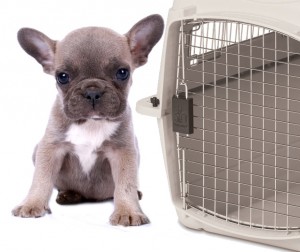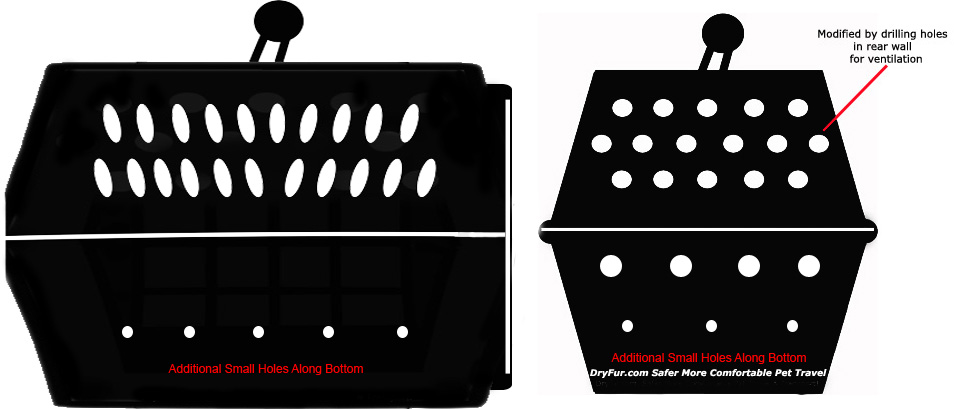
The A, B, C’s of Snub Nosed (Brachycephalic) Pet Flight Safety
With emotion, we at DryFur.com have been, sometimes with tears in our eyes, viewing the Pet Airline Incident reports since they were first released in May of 2005.
With purpose, we had to not avert our eyes to the realities, and we have been studying them to help bring information and resolutions to our readers so that the traveling pets can be safer, avoiding injury and sometimes, death.
Incidents, according to the airlines is death, injury or loss.
What was concluded was that the main categories of incident were from the following two issues.
1. Faulty unsecured kennels
2. Breathing and overheating issues for dogs with snub noses
Although the airlines do try to limit these incidents by requiring kennels to be secured with metal hardware and cable tying the doors closed, with the additional consideration being that snub-nosed pets can travel [usually] only when the forecast calls for temperatures to stay below 70-75 degrees.
Helpful, but not enough; as still over 50% of all reported pet deaths on airplanes are dogs and puppies who have snub noses, and according to the Department of Transportation, these animals are more at risk when flying in cargo than any other pets.
Snub – Short nosed pets include but are not limited to:
Boxers
Bulldogs
Pekinese
Pugs
Japanese Chins
Also of note are cats such as Persians and Burmese, as well as other exotic short-hair breeds.
VISIT American College of Vet Surgeons for great detail images and description of Brachycephalic Syndrome – Dog Noses and Airways
Dogs more commonly use panting to cool off yet snub nosed dogs still suffer more breathing and overheating issues than snub nosed cats, but both are at risk.
Here is what you can do to help pet airline travel to be safer for these special pets. Please pass this information along to anyone you know with a short nosed pet, even if they are not traveling anytime in the near future, so that they at least are aware of these concerns and resolutions.
A, B, C’s of Flying with a Snub Nosed Pet
A. What to do
- Purchase an airline kennel that is at least 1-2 sizes larger than required for your size pet to help provide plenty of air space around the pet.
- Make sure your kennel has ventilation on all four sides for Domestic and International flights, even though rules specify only required for International flights for Snub nosed pets more is always better. Modify by drilling additional ventilation holes in the back wall of kennel if they are lacking. Might even be good idea to add a few extra holes in bottom walls. This is the level your pets head (nose) will be at when in a lying down position, but just a few do not over do it or you could compromise the integrity of the kennel. See diagram below.
B. When to Fly & Preventative
- Only fly in cool temperatures, during the cooler weather seasons or late night-early morning. Do not assume your flights will all leave on time, if the temperature is expected to get hot on either end or at your connections during the day of your flight, RESCHEDULE. So in the event there is a delay for several hours or your pet misses a connecting flight, your pet does not end up flying in the heat of the day!
- Refrain from feeding snub nosed pets for 6-8 hours before flying or even longer. Autopsies results listed in the Airline Incident Reports have indicated that in some of these deaths, vomiting may have been a contributing factor. It is similar to preparing your pet for surgery where a full stomach can cause vomiting which can lead to a risk of breathing obstruction. Don’t feed many hours before shipping you can still mark the Shipper’s Declaration stating you offered food in the time required (you are not required to feed only required to “offer” food). Digesting food will raise body temperature and possibly result in air-sickness vomiting and snub nosed pets can not breath easily from their tiny sinuses if they are vomiting and panting simultaneously.
C. Day Of Flight
- Provide plenty of cool fresh water. Use a Stainless Steel Water Bucket (hook-on type) or you can cable tie to the door either will work. You should fill the bucket with water and freeze solid then attach to the kennel door this will help cool the air in an around your pet and also provide cool water when melted.
- Dampen or mist their bed, mat or cushion or look into the many dog cooling mats and pads available these will help keep your pet cool with evaporation.
- Do not tranquilize any pet before flying especially Snub Nosed.
After studying these Incident Reports and looking for possible solutions, we still believe it is a risk for Snub Nosed pets to travel in the cargo area of the Plane. So please research and look into other traveling options and only when you have no other option should you fly your snub nosed dogs in cargo.
For more information: http://www.dot.gov/affairs/2010/dot13810.html

